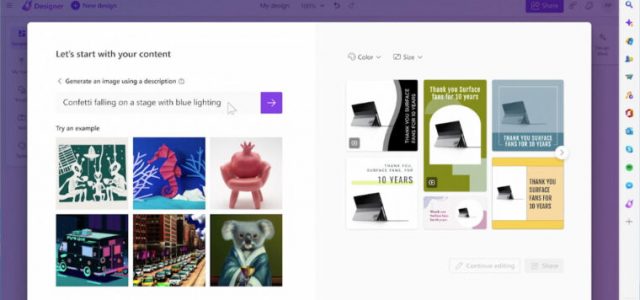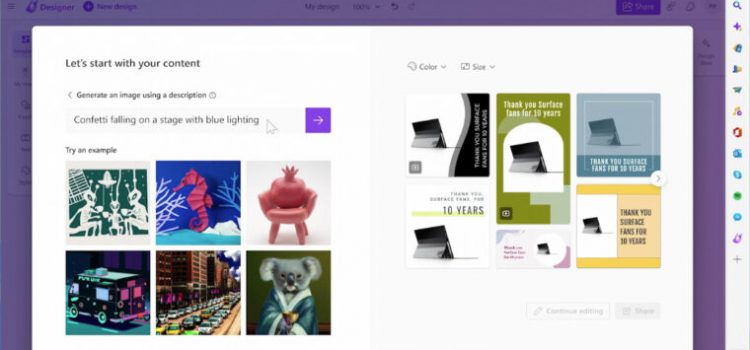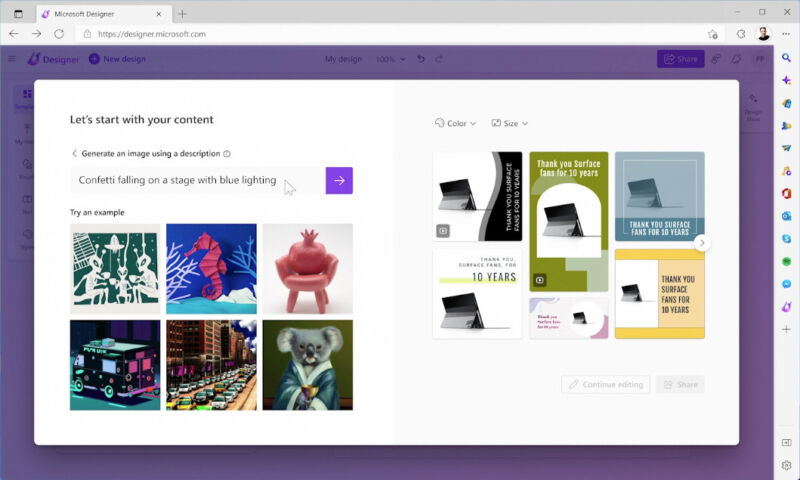



Microsoft
During a Surface press event today, Microsoft announced integrations of AI-powered image-generation technology into its Bing search engine, Edge browser, and a new Office app called Microsoft Designer. The technology will be powered by DALL-E 2 by OpenAI, which made waves in April for its ability to generate novel images based on written prompts. The technology has also been the subject of ire among some artists due to ethical concerns.
Microsoft’s offerings aim to help creators overcome blank-page syndrome by suggesting creative courses of action. In an example of Microsoft Designer provided by Microsoft, someone types a description of what they want to see, such as “Ombre cake decorated with flowers and fall foliage,” and they can then scroll through AI-generated image examples that they can choose to add to their design. “Designer invites you to start with an idea and let the AI do the heavy lifting,” wrote Microsoft in a press release.

Microsoft
Microsoft Designer originated as part of PowerPoint, where it currently suggests design ideas as a subset of that program. But Microsoft plans to break out Designer into its own Microsoft 365 app that will be available both as a free app and as a premium app available to Microsoft 365 Personal and Family subscribers. For now, Microsoft is limiting Designer to a free public web app, which it will use to gather feedback from public testing.

An animated GIF preview of Image Creator from Microsoft Bing, provided by Microsoft.
Microsoft
Microsoft also announced that it will be integrating Designer into Microsoft Edge to deliver “AI-powered design suggestions to visually enhance social media posts and other visual content without having to leave your browser window.” And AI image synthesis will also come to Bing with Image Creator, where people will be able to type in a prompt and get a novel result, powered by OpenAI’s DALL-E 2.
The ethical elephant in the room
Since OpenAI debuted DALL-E 2 in April, AI image generation has been controversial with some artists because of how it works. Image synthesis models like DALL-E 2 use deep-learning neural networks to analyze millions or billions of images found publicly on the web without seeking consent from artists or copyright holders. These models, including DALL-E competitor Stable Diffusion, statistically link the content of those images with descriptive captions found on the web to associate them with words. The result is that these models can generate images based on text descriptions, and they can imitate the distinctive styles of specific human artists.
Further, the creators of these image synthesis models caution that they reflect social biases such as racism and sexism in their training data, and they are also capable of producing disturbing or illegal imagery if safeguards are not put in place. Microsoft says it is addressing these issues: “To help prevent DALL∙E 2 from delivering inappropriate results across the Designer app and Image Creator, we are working ourselves and with our partner OpenAI, who developed DALL-E 2, to take steps and will continue to evolve our approach as needed.”
Mitigations include removing “the most explicit sexual and violent content” from the training dataset and adding filters to “limit generation of images that violate content policy.” Regarding bias, Microsoft mentions applying “additional technology that helps deliver more diverse images to our results,” which is likely the same as the random diverse prompt injections OpenAI introduced to DALL-E in July, which was met with some controversy itself. Perhaps because of these issues, Microsoft is taking a slow-release approach instead of completely opening the gates.
“We are taking a measured approach to roll out [Image Creator],” wrote Microsoft in a press release. “We will soon start with a limited preview for select geographies, which will allow us to gather feedback, apply learnings, and improve the experience before expanding further.”
With these moves from Microsoft, image synthesis tools are quickly becoming more mainstream. Canva added text-to-image generation capabilities in mid-September.
